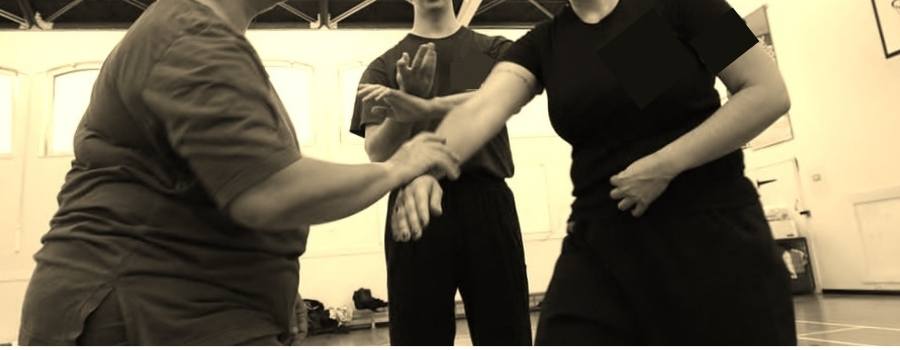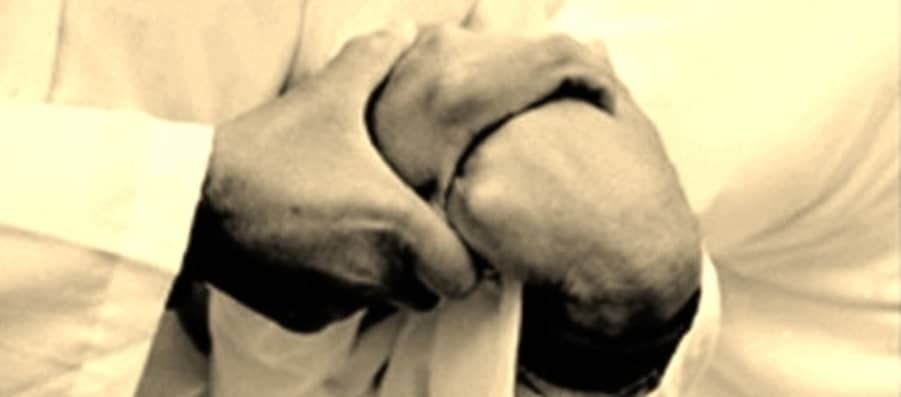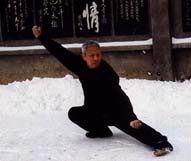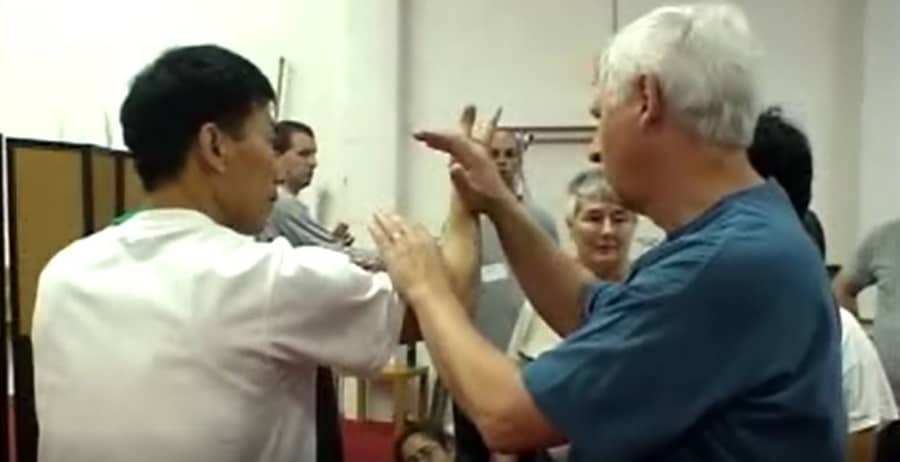There are tons of conflicting opinions about whether you can actually use tai chi to fight. If you search on tai chi fighting, two immediate things will come up: You will find tons of videos and articles showing tai chi fighting techniques. Right along side them, you will find videos of every martial art under the sun fighting tai chi practitioners and beating them. Even knocking them out! How can both be true? How can some people say they are using tai chi as a fighting art and yet there is not much proof to back it up?
Tai chi fighting techniques include strikes, kicks, throws, joint locks and use of weapons. The original curriculum was for and by military and revolutionary fighters. Modern tai chi practitioners do not often focus on the combat aspects and tai chi is generally no longer effective as a fighting art.
Spoiler Alert! I am not going to try to defend tai chi saying it’s better than any other martial art. I won’t even claim that tai chi would win in a street fight if it was “for real.”
Is Tai Chi a Martial Art?
What I am going to do here is talk about why tai chi IS a martial art and why most people cannot effectively use it in real combat today. If you are a tai chi practitioner, leaning into the hard side of our art has huge benefits, even if you don’t fight, so read on.
If you are a fighter in a different art, tai chi can reduce your injuries and increase your recovery. And from what I have experienced with teachers from China, you can reduce the amount of energy you burn in a session, improve your reaction time, and stay relaxed under attack.
Let’s start with a story…
Tai Chi Master Fighting
We were hosting a tai chi workshop and as luck would have it, an area martial arts school was willing to rent us their space for the weekend. This was a unique place because Brazilian Jujitsu, Karate, Capoeira, and Filipino Kale practitioners all contributed to the rent and reserved the mats on different nights of the week. Chen Tai Chi Master Chen Youze was traveling in the U.S. and we were able to host a conference and invite him down. Master Chen Youze (CY) is son of the recently deceased Chen Qingzhou. He is a formattable fighter having won Chinese national pushhands competitions before they changed the rules because of participants getting injured. Here he is teaching push hands and Chen tai chi fighting techniques.
Tai Chi Master Fighting Application Demonstration
On Saturday and Sunday afternoon of our workshop, several of the other schools members came to practice after the workshop ended. You can imagine how interested Master Chen Youze was in everything that everyone else was doing. At certain points, he stopped teaching and walked right into another class to watch their forms or fighting up close. It was a little awkward at first but people began smiling. Everyone warmed to the cross-discipline discussions that took place.
A ground fighter, I believe a BJJ/Capoeira practitioner asked: Why doesn’t tai chi do any ground fighting? What happens if you get taken to the ground?”
Master Chen Youze said: “What do you mean?” and the translator tried to explain. CY just said “show me.”
When the BJJ fighter asked CY to lay on the ground he laughed asking: “You want me to start on the ground??? Okay! Show me!” With the fighter on top using some sort of hold, CY exhaled and squeezed, exhaled and squeezed, and then bucked into him from the shoulder as the other guy started slapping the mat furiously to be let go.
To all of us, we really couldn’t see what was going on so CY explained. I am paraphrasing here but he said that he was being choked so he first had to relax into the choke until he was comfortable. Then, at his angle, he only had access to the ribs so he bear-hugged him trying to pop his ribs out or crack them. Then, he issued power from his shoulder – fa-jin into the ribs to try to crack them. Most modern practitioners he explained can only fa-jin when they are standing using their root. However, a trained tai chi fighter can issue energy from any point touching the ground. In this case, CY was grounding his shoulder blades and heals.
Soon, everyone was in. The translator who also practiced Systema tried to lock CY’s knee in a shin-to-shin leg lock. CY circled his knee in a deep stance, then locked the translator’s knee and shot him backwards onto his butt. The aikido teacher attempted a throw and was brought to the floor because CY used one hand to painfully locked the wrist that grabbed his shirt. The Karate instructor could not land a punch. In three attempts he was sidestepped, held in an uncomfortable position, and released.
What was shocking and awe-inspiring was that Master Chen Youze only used one leg or one arm/hand to do all this. Also, the camaraderie that developed in the room through the shared appreciation for the martial arts was palatable and really enjoyable to experience.
So, does tai chi really work in a fight?
The answer is yes. Practitioners that are focused on fighting and the traditional methods can be formattable fighters. In China, many of the teachers work for the police force and military teaching fighting and self defense. But there are four reasons why using tai chi fighting techniques would not work for most modern practitioners for real combat or in a street fight.
4 Reasons Why Tai Chi Fighting Techniques Are Not Effective
So the truth is that tai chi has the potential of being an effective fighting art but in most instances it is not. Don’t get me wrong, I love tai chi but it has its own inherent disadvantages. I present these modern limitations just to explain why someone wanting to quickly learn fighting skills might be better off in a different type of school. Tai chi is not effective for real combat for most modern practitioners because of:
1. Division of time
Most martial arts have a higher percentage of focus on fighting and combat. For MMA, BJJ, and boxing it is 100%. For arts tied to tournaments such as Taekwondo and Judo it is still a healthy amount of your training. For Karate and Tai Chi it is even less with some schools doing no or very little partner work or training. So if we take two equally skilled practitioners from two different arts, I think the major deciding factor is the percentage of time training to fight.
2. Abandonment of Push Hands
Tai Chi has a dedicated, robust system of drills and partner fighting that builds up to national and international fixed-step and moving-step competitions. This is the system that is used to train tai chi combat. If you want to see what this looks like you can’t search for Tai chi chuan Combat on YouTube because you will just get western examples. Search instead: 太极拳推手 which means “tai chi push hands” and 推手比赛 which means “push hands competitions. These tai chi fighting videos are better examples of what the art is capable of. Here is a good example. What I would like you to take away from this video is not only the fighting but that there is several decades of age difference between some competitors, 50+ year-olds are still competing, and there is a lot of smiling going on when someone gets beaten strategically.
Frankly, very few schools teach push hands curriculum outside of China. Many schools who are going the health route have abandoned it all together.
3. Individual vs. Partner Training
Tai chi has both individual and partner training. However, I would say that 80% of our class is spent on the individual activities like doing open hand and weapons forms versus doing push hands and applications. Karate, Boxing, and Taekwondo also have both, but I would bet they are more 50/50. Aikido and Jiujitsu are probably the opposite, 20/80. I feel this is akin to a runner who only jogs and lifts weights thinking he was going to win a race.
4. Who Is Practicing the Art
In the United States as an example, a tai chi class can range from age 18-80. Not all of these attendees are interested in fighting or application. Now, compare this with a BJJ school where the average age is much younger and the interest is in the fighting. Tai chi is limited in how much access we have to fight training, how many schools are focusing on this so we can all participate in competitions, and how many other individuals in our community fight so that we can practice. By and large, that’s just not what the art is focused on anymore.
So the confusion is completely understandable. Tai chi is a “martial art” by all definitions of the word. However, when you put it up against other modern “martial arts,” the playing field is no longer level. It’s not sad or something that needs to be defended, just a fact.
Tai Chi As A Fighting Art
This raises the question though: Is it useless to train the martial aspects of tai chi? To this I can answer with a resounding NO! My physical health, my tai chi form, my recovery from injury, have all benefitted from me learning both sides of tai chi. If you are a practitioner, keep up both focuses. If you practice a different martial art, you would benefit from not skipping past your arts “soft side” or “warm ups.” There might be more intelligence baked into them than you realize.
Advantages of Learning About Tai Chi as a Fighting Style
Using tai chi as a fighting art is completely debatable and not practical in most situations. But there are still huge martial and health benefits to not abandoning the part of the curriculum that was originally developed as a tai chi fighting style. By practicing tai chi, I have access to knowledge and material that not only gets me in shape, but heals me when I pull something or am trying to nurse myself back from an injury. Am I fighting or in push hands competitions these days? No. But other physical activities and work-related injuries catch up to me from time to time. Tai chi helps me avoid them all together or make sure they are short lived. Here are some examples.
Tai Chi Fighting Form Improves Everything About Your Posture and Your Tai Chi Form
What are some of the most common questions of students? Where do I put my hands? or Where does my foot go? or even How wide should my stance be? These are all questions about placement which is difficult to assess when you are standing in a posture on your own. If you asked someone to: “Pretend you are pushing something” versus “Pretend you are pushing a car out of a rut on an icy road.” Do you see how different their imitations would be?

Tai chi fighting form tells your body exactly where your hands, feet, and body should be in space. There is a move in the beginning of the tai chi form where the two palms travel sideways in front of the body. Honestly, new students look like they are waving goodbye or cleaning a window. When you partner up and explain that one hand holds a wrist and the other hand holds the elbow of someone you are pulling, everyone’s posture immediately looks beautiful.
There is a hidden, not often talked about aspect of martial posture. The same posture you hold to not get pushed over or defeated is the same posture that promotes health and blood flow. Back to our newbie example. Most people close their armpits and kua (inguinal crease) when they start tai chi. This crimps all the major blood vessels traveling to your appendages. A good fighting stance keeps your pelvis loose, armpits open like they are holding a racquetball, and your posture upright. You can correct a student 100 times and they still might not be consistent throughout the form. You can have them do push hands once and show them how not to get pushed over and the position of their joints remain open during the form.
Silk Reeling as a Way of Injury Prevention
The whole-body movements of tai chi initiate from the ground and travel out to the extremities. It is the process of learning how to use your big central muscles of the torso for movement rather than relying on the smaller ones. This is taught specifically through silk reeling and is a constant focus throughout the form. From a martial standpoint, imagine trying to move an opponent with your arms versus your whole body. Tai chi teaches this type of movement but it is easier to learn when you are working with a force against you like a weighted weapon or a push hands partner.
What I love about silk reeling is how I find problems that I didn’t know where there. If you are not familiar with silk reeling, a basic set of movements could be circling all the joints nine times, starting with your ankles and working towards the top of your head. Invariably, I get off work, go to class feeling great, start silk reeling and realize my shoulder is tweaky or my neck is tight because of something I did that day. Silk reeling works that out before it becomes a pain or bigger problem.
Chen Tai Chi Fighting Applications for Grappling
Chen tai chi is the best tai chi style for self defense. It teaches the art of Chin-na or grappling which has both martial and health benefits. On the martial side, being able to control someone else’s hands and take control if they grab you is paramount. On the health side, the same grapping applications of chin-na stretch, strengthen, and relax the muscles and tendons of your arms and hands. I type all day long but have none of the pains or fatigue that my colleagues do. I think it is in part due to focusing on my wrists in practice.

Throughout the tai chi form the hands are weaving through intricate patterns that are actually strikes, defenses, and joint locks. If your school is only health focused and you are not practicing tai chi as a fighting form, then your hand movements are probably limited or not moving as intricately as they should be.
Physical Fitness

Tai chi is not notorious for physical fitness. I doubt there will ever be a tai chi portion of Beach Body or P90X. But, it can get you in really good shape if you are in a school that is balancing the martial side with the health side. The deep stances of pole standing, the heavy weapons work, the tai chi ball set, are all exhausting.
I read a piece written by Wu Style tai chi master Wu Yinghua where she explained that tai chi has the ability to maintain your level of fitness at the age you start practicing. The current masters started young and that’s why they retain youthful movements and flexibility in their old age. She shared that whatever shape you are currently in, tai chi will help you to maintain that. This was in a talk she gave lamenting the fact that younger people are not practicing and tai chi is increasingly being seen as an activity for old people.
Push Hands is Calibrated Fighting
I have to say that I do miss the competition and fighting of wrestling and other martial arts that I have done in the past. However, I don’t miss going home to wrap my ankle or ice something. Honestly I am just past wearing an injury as a badge of progress. Tai chi push hands is a way to still wrestle, grapple, and improve technique that is extremely safe. You get the emotional high of competing and the camaraderie of working with a partner but don’t need a mouth guard or have to worry about your insurance deductible. If you are young and fighting and enjoying it, then onward! I was there once and envy you a bit. But I am still at it in my 40s and don’t see a need to stop. There are members of our tai chi class with hard-style backgrounds who are still pushing hands in their 60s.



